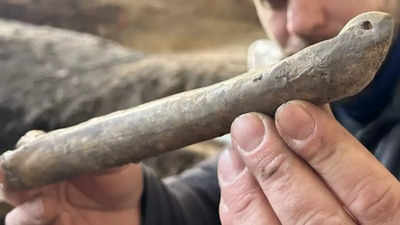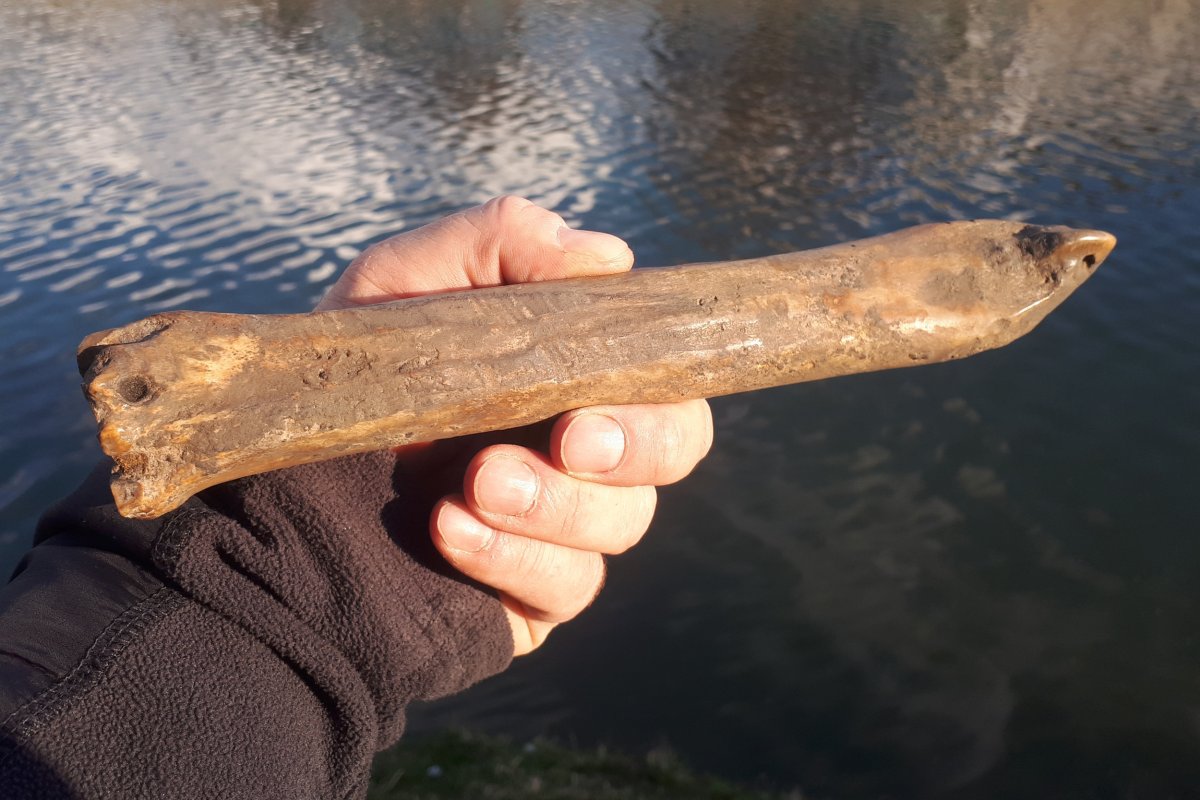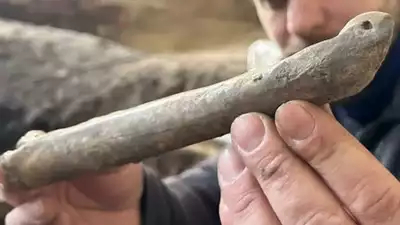In the second half of March, Google sent me a bunch of news articles about a bone skate found in Přerov, a city in the Czech Republic. This post is a summary meant to track the evolution of the story. There are of course many more articles and blog posts about this skate. I doubt this blog post will get picked up by Google’s alerts.
On March 14, Radio Prague International broke the news with an article by Ruth Fraňková that included photos and an audio interview with archaeologist Zdeněk Schenk with an English voice-over. That audio was the source for the interview fragments quoted over the next few weeks.
Schenk and his team dated the skate to the 10th or 11th century. It was made from a horse metapodium with the toe pointed and upswept. There is a small hole at the front and another (not mentioned in the first few articles) at the back.
All these articles focus on the “tools” aspect of bone skates, suggesting that people used them to travel and carry stuff across frozen waterways. This contrasts with the evidence from Scandinavia, where skates were generally used for fun. But so far, the articles are pretty good about sticking to the facts and providing correct information.

Google sent me its first update the next day, March 15. That link was to an article on BNN with the headline “Archaeologists Unearth Thousand-Year-Old Bone Ice Skate in Moravian City of Přerov”. Unfortunately the link doesn’t work any more.
A couple of other articles covering basically the same information appeared in the next few days. Mark Milligan published an article about the skate in Heritage Daily on March 16, and the Times of India published an anonymous article that, as of this writing, was last updated on March 18.
On March 20, Oguz Buyukyildirim provided a few more details in an article on Arkeonews: The bone is a metacarpus, and similar skates have been found in the past. Buyukyildirim cites specifically one skate found in 2009, but adds that “more such blades have been unearthed over the years in the wider area of the city.”
The next few articles didn’t add much other than a few more quotes from Schenk’s interview:
- Christopher Plain‘s longer investigation, published on March 21 in the Debrief, quotes Schenk a few times as he describes skating with a pole and other skates from Central Europe and Scandinavia, especially in Viking settlements.
- Abdul Moeed‘s article, published that same day in the Greek Reporter, gets more excited about the Vikings, but doesn’t provide any new information.
- Amber Breese‘s article, published the very next day (March 22), includes some of the same details.
Slightly later, some more details emerged in a Newsweek article published on March 23 and updated on March 26. Now the skate has an additional hole at the heel. The article also mentions another skate found in the same city in 2009 and “nearly identical” skates found in specific places: Birka, York, and Dublin.

Things started to go off the rails on March 25, when Deseret News published Xochitl Bott Rivera’s article “Did archaeologists find the oldest ice skate ever?”. The correct answer to that is, of course, “No”. The oldest skates are close to 3000 years older than this one. Eventually the article does admit that, citing the Chinese skates found not too long ago. Along the way, it quotes Federico Formenti via Smithsonian Magazine.
The skate remained popular in various news outlets a bit longer; subsequent articles stuck to the facts quoted in earlier articles:
- Angel Saunders’ article “1,000-Year-Old Ice Skate Discovered in Czech Republic, But It’s Not Made of Metal” was published in Yahoo! Life and People on March 25 and in Prague Morning on March 26.
- Sonja Anderson’s article, which appeared in Smithsonian Magazine and MSN on March 28, includes a nice retrospective on the Schenk’s childhood skating on the same river.
- The BBC covered the find on March 30.
- Samantha Franco published an article in The Vintage News on April 1.
- Emily Chan published an article in Chip Chick on April 4.
- Andy Corbley’s article in Good News Network, published on April 5, includes the retrospective from Anderson’s article as a quote from GNN’s interview with Schenk.
As for the skate’s future, Prague Radio and Oguz Buyukyildirim note that it will be put on display at the Comenius Museum in Přerov Castle.
The thousand-year-old skate discovered by archaeologists in Přerov will soon be shown to the public. It will go on display at the city’s castle as part of an exhibition dedicated to the history of the region.
Prague Radio International, March 14, 2024

